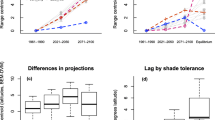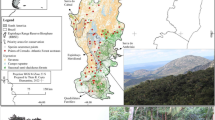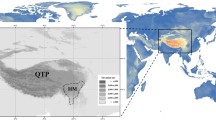Abstract
Climate change is a threat to natural ecosystems. To evaluate this threat and, where possible, respond, it is useful to understand the potential impacts climate change could have on species’ distributions, phenology, and productivity. Here, we compare future-scenario outcomes between a dynamic vegetation model (DVM; CARbon Assimilation In the Biosphere (CARAIB)) and an ecological niche-based model (ENM; maximum entropy model) to outline the risks to tree species in the Brazilian Atlantic Forest, comprising the habitats of several endemic species, including the endangered primate Leontopithecus chrysomelas (golden-headed lion tamarin; GHLT), our species of interest. Compared to MaxENT, the DVM predicts larger present-day species ranges. Conversely, MaxENT ranges are closer to sampled distributions of the realised niches. MaxENT results for two future scenarios in four general circulation models suggest that up to 75% of the species risk losing more than half of their original distribution. CARAIB simulations are more optimistic in scenarios with and without accounting for potential plant-physiological effects of increased CO2, with less than 10% of the species losing more than 50% of their range. Potential gains in distribution outside the original area do not necessarily diminish risks to species, as the potential new zones may not be easy to colonise. It will also depend on the tree species’ dispersal ability. So far, within the current range of L. chrysomelas, CARAIB continues to predict persistence of most resource trees, while MaxENT predicts the loss of up to 19 species out of the 59 simulated. This research highlights the importance of choosing the appropriate modelling approach and interpretation of results to understand key processes.







Similar content being viewed by others
References
Allouche O, Tsoar A, Kadmon R (2006) Assessing the accuracy of species distribution models: prevalence, kappa and the true skill statistic (TSS). J Appl Ecol 43:1223–1232. https://doi.org/10.1111/j.1365-2664.2006.01214.x
Bedia J, Busqué J, Gutiérrez JM (2011) Predicting plant species distribution across an alpine rangeland in northern Spain. A comparison of probabilistic methods. Appl Veg Sci 14:415–432. https://doi.org/10.1111/j.1654-109X.2011.01128.x
Boyles JG, Seebacher F, Smit B, McKechnie AE (2011) Adaptive thermoregulation in endotherms may alter responses to climate change. Integr Comp Biol 51:676–690. https://doi.org/10.1093/icb/icr053
Brooker RW, Travis JMJ, Clark EJ, Dytham C (2007) Modelling species’ range shifts in a changing climate: the impacts of biotic interactions, dispersal distance and the rate of climate change. J Theor Biol 245:59–65. https://doi.org/10.1016/j.jtbi.2006.09.033
Carnaval AC, Moritz C (2008) Historical climate modelling predicts patterns of current biodiversity in the Brazilian Atlantic forest. J Biogeogr 35:1187–1201. https://doi.org/10.1111/j.1365-2699.2007.01870.x
Carolan K, Ebong SM, Garchitorena A, Landier J, Sanhueza D, Texier G, Marsollier L, Le Gall P, Guégan J-F, Lo Seen D (2014) Ecological niche modelling of Hemipteran insects in Cameroon; the paradox of a vector-borne transmission for Mycobacterium ulcerans, the causative agent of Buruli ulcer. Int J Health Geogr 13:44. https://doi.org/10.1186/1476-072X-13-44
Cleland EE, Chuine I, Menzel A, Mooney HA, Schwartz MD (2007) Shifting plant phenology in response to global change. Trends Ecol Evol 22:357–365. https://doi.org/10.1016/j.tree.2007.04.003
Cleveland CC, Townsend AR, Taylor P, Alvarez-Clare S, Bustamante MMC, Chuyong G, Dobrowski SZ, Grierson P, Harms KE, Houlton BZ, Marklein A, Parton W, Porder S, Reed SC, Sierra CA, Silver WL, Tanner EVJ, Wieder WR (2011) Relationships among net primary productivity, nutrients and climate in tropical rain forest: a pan-tropical analysis. Ecol Lett 14:939–947. https://doi.org/10.1111/j.1461-0248.2011.01658.x
Collins K, du Toit JT (2016) Population status and distribution modelling of the critically endangered riverine rabbit (Bunolagus monticularis). Afr J Ecol 54:195–206. https://doi.org/10.1111/aje.12285
Colombo AF, Joly CA (2010) Brazilian Atlantic Forest lato sensu: the most ancient Brazilian forest, and a biodiversity hotspot, is highly threatened by climate change. Braz J Biol 70:697–708. https://doi.org/10.1590/S1519-69842010000400002
Cramer W, Bondeau A, Woodward FI, Prentice IC, Betts RA, Brovkin V, Cox PM, Fisher V, Foley JA, Friend AD, Kucharik C, Lomas MR, Ramankutty N, Sitch S, Smith B, White A, Young-Molling C (2001) Global response of terrestrial ecosystem structure and function to CO2 and climate change: results from six dynamic global vegetation models. Glob Chang Biol 7:357–373. https://doi.org/10.1046/j.1365-2486.2001.00383.x
de Araújo FM, Ferreira LG, Arantes AE (2012) Distribution patterns of burned areas in the Brazilian biomes: an analysis based on satellite data for the 2002-2010 period. Remote Sens 4:1929–1946. https://doi.org/10.3390/rs4071929
Deutsch CA, Tewksbury JJ, Huey RB, Sheldon KS, Ghalambor CK, Haak DC, Martin PR (2008) Impacts of climate warming on terrestrial ectotherms across latitude. Proc Natl Acad Sci 105:6668–6672. https://doi.org/10.1073/pnas.0709472105
Dury M (2015) Modelling the dynamics of European ecosystems from the early Holocene to the end of the 21st century with the CARAIB dynamic vegetation model. University of Liege
Dury M, Hambuckers A, Warnant P, Henrot A, Favre E, Ouberdous M, Fran Ois L (2011) Responses of European forest ecosystems to 21 st century climate: assessing changes in interannual variability and fire intensity. iForest Biogeosciences For 4:82–99. https://doi.org/10.3832/ifor0572-004
Elith J, Graham CH, Anderson RP, Dudík M, Ferrier S, Guisan A, Hijmans RJ, Huettmann F, Leathwick J, Lehmann A, Li J, Lohmann L, Loiselle B, Manion G, Moritz C, Nakamura M, Nakazawa Y, Overton JMcC, Townsend Peterson A, Phillips S, Richardson K, Scachetti-Pereira R, Schapire R, Soberón J, Williams S, Wisz M, Zimmermann NE (2006) Novel methods improve prediction of species’ distributions from occurrence data. Ecography (Cop) 29:129–151. https://doi.org/10.1111/j.2006.0906-7590.04596.x
Elith J, Leathwick JJR (2009) Species distribution models: ecological explanation and prediction across space and time. Annu Rev Ecol Evol 40:677–697. https://doi.org/10.1146/annurev.ecolsys.110308.120159
Elith J, Phillips SJ, Hastie T, Dudík M, Chee YE, Yates CJ (2011) A statistical explanation of MaxEnt for ecologists. Divers Distrib 17:43–57. https://doi.org/10.1111/j.1472-4642.2010.00725.x
Estrada A, Coates-Estrada R, Meritt D, Montiel S, Curiel D (1993) Patterns of frugivore species richness and abundance in forest islands and in agricultural habitats at Los Tuxtlas, Mexico. Vegetatio 107–108:245–257. https://doi.org/10.1007/BF00052227
Fleming TH, Breitwisch R, Whitesides GH (1987) Patterns of tropical vertebrate frugivore diversity. Annu Rev Ecol Syst 18:91–109. https://doi.org/10.1146/annurev.es.18.110187.000515
François L, Ghislain M, Otto D, Micheels A (2006) Late Miocene vegetation reconstruction with the CARAIB model. Palaeogeogr Palaeoclimatol Palaeoecol 238:302–320. https://doi.org/10.1016/j.palaeo.2006.03.034
François L, Utescher T, Favre E, Henrot AJ, Warnant P, Micheels A, Erdei B, Suc JP, Cheddadi R, Mosbrugger V (2011) Modelling Late Miocene vegetation in Europe: results of the CARAIB model and comparison with palaeovegetation data. Palaeogeogr Palaeoclimatol Palaeoecol 304:359–378. https://doi.org/10.1016/j.palaeo.2011.01.012
Francois LM, Delire C, Warnant P, Munhoven G (1998) Modelling the glacial—interglacial changes in the continental biosphere. Glob Planet Change 16–17:37–52
Franklin J, Davis FW, Ikegami M, Syphard AD, Flint LE, Flint AL, Hannah L (2013) Modeling plant species distributions under future climates: how fine scale do climate projections need to be? Glob Chang Biol 19:473–483. https://doi.org/10.1111/gcb.12051
Franklin J, Serra-Diaz JM, Syphard AD, Regan HM (2016) Global change and terrestrial plant community dynamics. Proc Natl Acad Sci 113:3725–3734. https://doi.org/10.1073/pnas.1519911113
Gerard JC, Nemry B, Francois LM, Warnant P (1999) The interannual change of atmospheric CO2: contribution of subtropical ecosystems? Geophys Res Lett 26:243–246. https://doi.org/10.1029/1998gl900269
Gonzalez P, Neilson RP, Lenihan JM, Drapek RJ (2010) Global patterns in the vulnerability of ecosystems to vegetation shifts due to climate change. Glob Ecol Biogeogr 19:755–768. https://doi.org/10.1111/j.1466-8238.2010.00558.x
Guisan A, Thuiller W (2005) Predicting species distribution: offering more than simple habitat models. Ecol Lett 8:993–1009. https://doi.org/10.1111/j.1461-0248.2005.00792.x
Helmuth B, Kingsolver JG, Carrington E (2005) Biophysics, physiological ecology, and climate change: does mechanism matter? Annu Rev Physiol 67:177–201. https://doi.org/10.1146/annurev.physiol.67.040403.105027
Henrot AJ, François L, Favre E, Butzin M, Ouberdous M, Munhoven G (2010) Effects of CO2, continental distribution, topography and vegetation changes on the climate at the Middle Miocene: a model study. Clim Past 6:675–694. https://doi.org/10.5194/cp-6-675-2010
Hickler T, Rammig A, Werner C (2015) Modelling CO2 impacts on forest productivity. Curr For Reports 1:69–80. https://doi.org/10.1007/s40725-015-0014-8
Kearney M, Porter W (2009) Mechanistic niche modelling: combining physiological and spatial data to predict species’ ranges. Ecol Lett 12:334–350. https://doi.org/10.1111/j.1461-0248.2008.01277.x
Khanum R, Mumtaz AS, Kumar S (2013) Predicting impacts of climate change on medicinal asclepiads of Pakistan using Maxent modeling. Acta Oecol 49:23–31. https://doi.org/10.1016/j.actao.2013.02.007
Landis JR, Koch GG (1977) The measurement of observer agreement for categorical data. Biometrics 33:159–174. https://doi.org/10.2307/2529310
Laurent JM, Bar-Hen A, François L, Ghislain M, Cheddadi R (2004) Refining vegetation simulation models: from plant functional types to bioclimatic affinity groups of plants. J Veg Sci 15:739–746. https://doi.org/10.1658/1100-9233(2004)015[0739:RVSMFP]2.0.CO;2
Laurent JM, François L, Bar-Hen A, Bel L, Cheddadi R (2008) European bioclimatic affinity groups: data-model comparisons. Glob Planet Change 61:28–40. https://doi.org/10.1016/j.gloplacha.2007.08.017
Merow C, Smith MJ, Silander JA (2013) A practical guide to MaxEnt for modeling species’ distributions: what it does, and why inputs and settings matter. Ecography (Cop) 36:1058–1069. https://doi.org/10.1111/j.1600-0587.2013.07872.x
Mittermeier RA, Valladares-Pádua C, Rylands AB, Eudey AA, Butynski TM, Ganzhorn JU, Kormos R, Aguiar JM, Walker S (2005) Primates in peril: The world’s 25 most endangered primates 2004–2006. Washington, DC: Report to IUCN/SSC Primate Specialist Group (PSG), International Primatological Society (IPS), and Conservation International (CI). 1–47
Monzón J, Moyer-Horner L, Palamar MB (2011) Climate change and species range dynamics in protected areas. Bioscience 61:752–761. https://doi.org/10.1525/bio.2011.61.10.5
Moss RH, Edmonds JA, Hibbard KA, Manning MR, Rose SK, van Vuuren DP, Carter TR, Emori S, Kainuma M, Kram T, Meehl GA, JFB M, Nakicenovic N, Riahi K, Smith SJ, Stouffer RJ, Thomson AM, Weyant JP, Wilbanks TJ (2010) The next generation of scenarios for climate change research and assessment. Nature 463:747–756. https://doi.org/10.1038/nature08823
Myers N, Mittermeier RA, Mittermeier CG, da Fonseca GAB, Kent J (2000) Biodiversity hotspots for conservation priorities. Nature 403:853–858. https://doi.org/10.1038/35002501
Otto D, Rasse D, Kaplan J, Warnant P, François L (2002) Biospheric carbon stocks reconstructed at the Last Glacial Maximum: comparison between general circulation models using prescribed and computed sea surface temperatures. Glob Planet Change 33:117–138. https://doi.org/10.1016/S0921-8181(02)00066-8
Pan S, Tian H, Dangal SRS, Zhang C, Yang J, Tao B, Ouyang Z, Wang X, Lu C, Ren W, Banger K, Yang Q, Zhang B, Li X (2014) Complex spatiotemporal responses of global terrestrial primary production to climate change and increasing atmospheric CO2 in the 21st century. PLoS One 9:e112810. https://doi.org/10.1371/journal.pone.0112810
Peres CA, van Roosmalen M (2002) Primate frugivory in two species-rich neotropical forests: implications for the demography of large-seeded plants in overhunted areas. In: Seed dispersal and frugivory: ecology, evolution and conservation. Third International Symposium-Workshop on Frugivores and Seed Dispersal, São Pedro, Brazil, 6–11 August 2000. CABI, Wallingford, pp 407–421
Phillips SJ, Dudík M (2008) Modeling of species distribution with Maxent: new extensions and a comprehensive evalutation. Ecograpy 31:161–175. https://doi.org/10.1111/j.2007.0906-7590.05203.x
Raghunathan N, Francois L, Huynen MC, Oliveira LC, Hambuckers A (2015) Modelling the distribution of key tree species used by lion tamarins in the Brazilian Atlantic forest under a scenario of future climate change. Reg Environ Chang 15:683–693. https://doi.org/10.1007/s10113-014-0625-9
Rammig A, Jupp T, Thonicke K, Tietjen B, Heinke J, Lucht W, Cramer W, Cox P, Jupp T (2010) Estimating the risk of Amazonian forest dieback estimating. New Phytol 187:694–706. https://doi.org/10.1111/j.1469-8137.2010.03318.x
Reich PB, Hobbie SE, Lee TD (2014) Plant growth enhancement by elevated CO2 eliminated by joint water and nitrogen limitation. Nat Geosci 7:920–924. https://doi.org/10.1038/ngeo2284
Root TL, Schneider SH (2006) Conservation and climate change: the challenges ahead. Conserv Biol 20:706–708. https://doi.org/10.1111/j.1523-1739.2006.00465.x
Root TL, Price JT, Hall KR, Schneider SH (2003) Fingerprints of global warming on wild animals and plants. 57–60. doi: https://doi.org/10.1038/nature01309.1
Sitch S, Smith B, Prentice IC, Arneth A, Bondeau A, Cramer W, Kaplan JO, Levis S, Lucht W, Sykes MT, Thonicke K, Venevsky S (2003) Evaluation of ecosystem dynamics, plant geography and terrestrial carbon cycling in the LPJ dynamic global vegetation model. Glob Chang Biol 9:161–185. https://doi.org/10.1046/j.1365-2486.2003.00569.x
Smith NG, Dukes JS (2013) Plant respiration and photosynthesis in global-scale models: incorporating acclimation to temperature and CO2. Glob Chang Biol 19:45–63. https://doi.org/10.1111/j.1365-2486.2012.02797.x
Snell RS, Huth A, Nabel JEMS, Bocedi G, Travis JMJ, Gravel D, Bugmann H, Gutiérrez AG, Hickler T, Higgins SI, Reineking B, Scherstjanoi M, Zurbriggen N, Lischke H (2014) Using dynamic vegetation models to simulate plant range shifts. Ecography (Cop) 37:1184–1197. https://doi.org/10.1111/ecog.00580
Steinbauer MJ, Grytnes JA, Jurasinski G, Kulonen A, Lenoir J, Pauli H, Rixen C, Winkler M, Bardy-Durchhalter M, Barni E, Bjorkman AD, Breiner FT, Burg S, Czortek P, Dawes MA, Delimat A, Dullinger S, Erschbamer B, Felde VA, Fernández-Arberas O, Fossheim KF, Gómez-García D, Georges D, Grindrud ET, Haider S, Haugum SV, Henriksen H, Herreros MJ, Jaroszewicz B, Jaroszynska F, Kanka R, Kapfer J, Klanderud K, Kühn I, Lamprecht A, Matteodo M, Di Cella UM, Normand S, Odland A, Olsen SL, Palacio S, Petey M, Piscová V, Sedlakova B, Steinbauer K, Stöckli V, Svenning JC, Teppa G, Theurillat JP, Vittoz P, Woodin SJ, Zimmermann NE, Wipf S (2018) Accelerated increase in plant species richness on mountain summits is linked to warming. Nature 556:231–234. https://doi.org/10.1038/s41586-018-0005-6
Taylor KE (2001) Summarizing multiple aspects of model performance in a single diagram. J Geophys Res Atmos 106:7183–7192. https://doi.org/10.1029/2000JD900719
Taylor KE, Stouffer RJ, Meehl GA (2012) An overview of CMIP5 and the experiment design. Bull Am Meteorol Soc 93:485–498. https://doi.org/10.1175/BAMS-D-11-00094.1
Thomas CD (2010) Climate, climate change and range boundaries. Divers Distrib 16:488–495. https://doi.org/10.1111/j.1472-4642.2010.00642.x
Thomas CD, Thomas CD, Cameron A, Cameron A, Green RE, Green RE, Bakkenes M, Bakkenes M, Beaumont LJ, Beaumont LJ, Collingham YC, Collingham YC, Erasmus BFN, Erasmus BFN, De Siqueira MF, De Siqueira MF, Grainger A, Grainger A, Hannah L, Hannah L, Hughes L, Hughes L, Huntley B, Huntley B, Van Jaarsveld AS, Van Jaarsveld AS, Midgley GF, Midgley GF, Miles L, Miles L, Ortega-Huerta MA, Ortega-Huerta MA, Peterson AT, Peterson AT, Phillips OL, Phillips OL, Williams SE, Williams SE (2004) Extinction risk from climate change. Nature 427:145–148. https://doi.org/10.1038/nature02121
Townsend Peterson A, Papeş M, Eaton M (2007) Transferability and model evaluation in ecological niche modeling: a comparison of GARP and Maxent. Ecography (Cop) 30:550–560. https://doi.org/10.1111/j.2007.0906-7590.05102.x
VanDerWal J, Shoo LP, Graham C, Williams SE (2009) Selecting pseudo-absence data for presence-only distribution modeling: how far should you stray from what you know? Ecol Model 220:589–594. https://doi.org/10.1016/j.ecolmodel.2008.11.010
Vasconcelos R, Brito JC, Carvalho SB, Carranza S, James Harris D (2012) Identifying priority areas for island endemics using genetic versus specific diversity—the case of terrestrial reptiles of the Cape Verde Islands. Biol Conserv 153:276–286. https://doi.org/10.1016/j.biocon.2012.04.020
Walther GR (2010) Community and ecosystem responses to recent climate change. Philos Trans R Soc B Biol Sci 365:2019–2024. https://doi.org/10.1098/rstb.2010.0021
Walther G-R, Beißner S, Burga CA (2005) Trends in the upward shift of alpine plants. J Veg Sci 16:541. https://doi.org/10.1658/1100-9233(2005)16[541:TITUSO]2.0.CO;2
Warnant P, François L, Strivay D, Gérard J-C (1994) CARAIB: a global model of terrestrial biological productivity. Glob Biogeochem Cycles 8:255–270. https://doi.org/10.1029/94GB00850
Williams JW, Jackson ST (2007) Novel climates, no-analog communities, and ecological surprises. Front Ecol Environ 5:475–482. https://doi.org/10.1890/1540-9295(2007)5[475:NCNCAE]2.0.CO;2
Williams SE, Shoo LP, Isaac JL, Hoffmann AA, Langham G (2008) Towards an integrated framework for assessing the vulnerability of species to climate change. PLoS Biol 6:e325. doi: https://doi.org/10.1371/journal.pbio.0060325, 2621, 2626
Acknowledgements
This work was funded by FNRS-F.R.I.A. and in part by the Wallonie-Brussels International (WBI). We would also like to acknowledge the BIOSERF and AFRIFORD projects from the Belgian Science Policy (BELSPO). Global land cover data were obtained from the ESA GlobCover 2009 Project and Université Catholique de Louvain (http://due.esrin.esa.int/page_globcover.php).
Author information
Authors and Affiliations
Corresponding author
Additional information
Editor:Wolfgang Cramer.
Electronic supplementary material
ESM 1
(DOC 4389 kb)
Rights and permissions
About this article
Cite this article
Raghunathan, N., François, L., Dury, M. et al. Contrasting climate risks predicted by dynamic vegetation and ecological niche-based models applied to tree species in the Brazilian Atlantic Forest. Reg Environ Change 19, 219–232 (2019). https://doi.org/10.1007/s10113-018-1405-8
Received:
Accepted:
Published:
Issue Date:
DOI: https://doi.org/10.1007/s10113-018-1405-8




